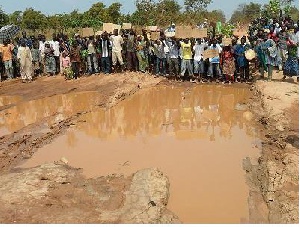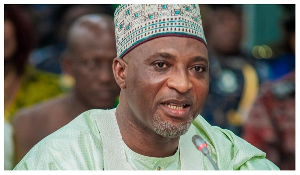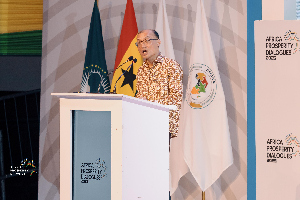It is hard to remember how many times the Bimbila-Yendi road has been talked about by politicians and common citizens alike. And yet nothing changes every passing year.
Reading the news about the inauguration of a nine-member Board of Directors of the Savannah Accelerated Development Authority (SADA) by President Mills on 22nd December 2010 was elating especially because one of the pillars of SADA is infrastructure development. The news about SADA immediately threw my mind back to my most recent journey to my holy village of Bimbilla.
The 43-Mile road between Yendi and Bimbila – along which there are 12 significantly large villages - was in a terrible state even before the season’s heavy rains gained currency. By the middle of the rainy season, in spite of the “bandaging” by grading some sections of the road, it deteriorated to the usual state as in the picture below. As readers may note, the road is littered with many dug-outs such as in the picture stretching up at to 20 miles. It is hard to imagine that this is a major road in a so called middle income country like Ghana. It is certainly a vivid example of total neglect by government in the past 20 years.
(Picture by Savannah News, Tamale)
As I have written before on this subject, the Bimibla-Yendi road is so terrible beyond imagination and the people who depend on this road get apprehensive whenever the rainy seaon, which renders it unmotorable sets in. I am aware that this year (2010) the District Chief Executive made efforts to have sections of the road graded before the peak of the rains. That is all a district assembly is capable of doing, given the meager resources at its disposal. And although this action by the DCE was laudable, the problem with grading that is not accompanied by compacting with heavy machinery is that it renders the road more susceptible to being washed away by the torrential rains. One would notice that such tokenistic and stop-gap measures are only measures of last resort in the absence of more durable solutions.
The thrust of this article is to drive home the obvious point that the poor state of this road cannot be rectified by local governments alone and the near certainty of the failure government to deliver which often follows every policy announcement since 2001 makes one wonder whether anything will ever happen to improve transportation along this productive corridor. It has become obvious that in the absence of representatives like Dr. Ibn Chambas no politician is ready to stand up and advocate for something to be done.
A friend of mine who travelled the road in October 2010 said that it is the most horrible road he has ever seen in Ghana. He agreed with my suggestion that the solution does not lie in playing politics with the people of Bimbila. Rather a comprehensive, all-inclusive advocacy group is required to ensure that public and private sector institutions listen to the call to rehabilitate the road. For me, reading about SADA appeared to give me hope. The SADA policy initiative is aimed at addressing the development asymmetry that exists between Northern and Southern Ghana through strategic investment in six areas including the modernisation of agriculture; development of strategic infrastructure and private sector involvement.
It is within the goal of strategic infrastructure development that I see salvation for the Bimbila road. Within the strategic infrastructure initiative, there is the need to identify areas of deficits that have the potential to deconstruct the bottlenecks created by decades of policy failures. To my mind, roads that link the north to the south are very important. And although a number of roads come under this category, the Yendi – Bimibilla – Hohoe road, (usually called the eastern –corridor road) is a major artery in terms of communication and the delivery of vital economic outputs to and from northern Ghana. I am of the view that SADA should focus on getting this road to a reasonable standard for two obvious reasons.
1. The development of this road serves three of SADA’s six main pillars- modernisation of agriculture; development of strategic infrastructure; strong linkage between Northern Savannah and the Sahelian countries. The road has this unique position because it runs through one of the richest agricultural regions stretching from northern Ghana to the Volta region, which is part of the SADA target areas. 2. The rehabilitation of the road would accelerate the flow of valuable agricultural produce such as Yams, Onions, cattle, etc which are often transported through the Gambaga area and Bawku to Burkina Faso and Niger. Thus an alternative major South-North is opened up to support the Kintampo-Tamale-Paga road. Some people may argue that plans are being drawn to develop the eastern corridor roads network through the 10 Billion dollar infrastructure loan deal signed by President Mills and the Government of China for in September, 2010. However this imitative will take time and there is no guarantee that it will be executed. To my mind, an accelerated development agenda such as the one being championed by SADA needs to set priorities that provide the best advantage for further growth. I believe this road is one that should be prioritised.
I want to use this opinion piece to appeal to all well-meaning people in Bimbila, Yendi, as well as other relevant bodies such as SADA to petition Government to take immediate action on this significant issue. The road is important to the country’s economic development and an integral part of any effort to progress the general welfare of the populations that rely on this road for essential life services.
Please join the call to petition the Government on the state of this road. You can make a call to radio stations to discuss this issue, send letters to relevant Governments ministries and departments or create a network of NGOs and CSOs to collectively petition the Government before the next rainy season.
By Dr. Ahmed Bawa Kuyini (CEVS-Ghana, Tamale & Bimbila)
Opinions of Tuesday, 4 January 2011
Columnist: Kuyini, Ahmed Bawa



















